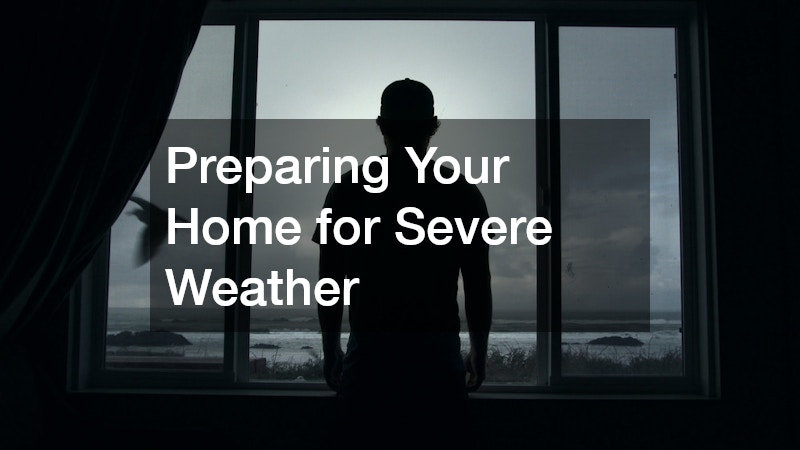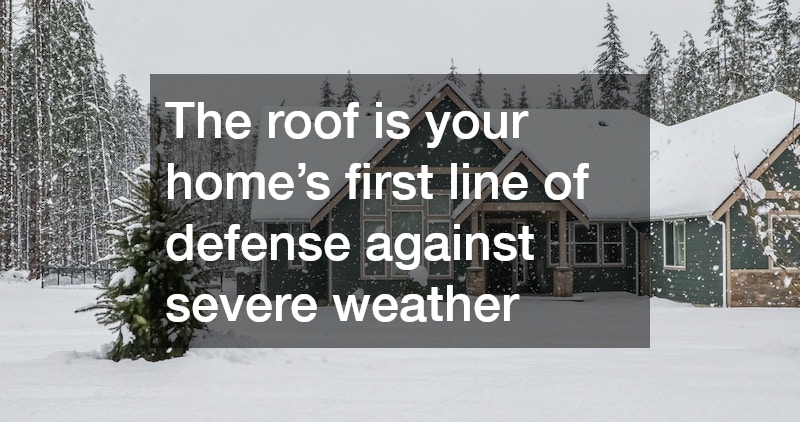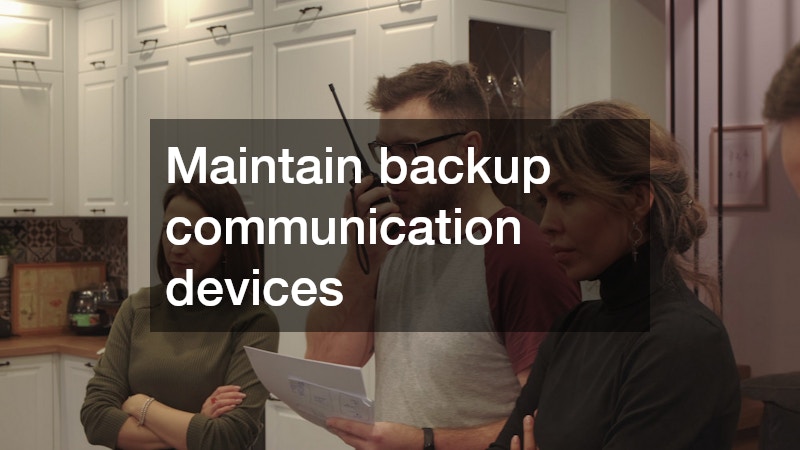

Severe weather events such as storms, hurricanes, and heavy rains can cause significant damage to homes if you are not adequately prepared. From leaking roofs and flooded basements to power outages and structural damage, the costs of unpreparedness can be substantial. Homeowners who take proactive steps can not only protect their property but also ensure the safety of their family and reduce stress during emergency situations. Preparing for severe weather requires a combination of preventive maintenance, careful inspections, and collaboration with experienced professionals.
This guide provides practical advice on steps homeowners can take to safeguard their property, highlighting areas that often get overlooked until it’s too late. By addressing potential vulnerabilities before a storm hits, you can minimize risk and ensure that your home withstands even the harshest weather conditions.
Assessing Vulnerabilities and Preparing for Power Outages
Power outages are among the most immediate and disruptive consequences of severe weather. When electricity fails, critical systems such as heating, cooling, water pumps, and lighting can become nonfunctional, putting both residents and property at risk. During prolonged outages, homes without adequate preparation can experience additional problems, including frozen pipes in winter, overheating in summer, or accidents caused by poor visibility. Therefore, preparing for power disruptions is a key aspect of overall storm readiness.
1. Installing Reliable Emergency Lighting
Reliable emergency lighting is essential to maintain safety when the grid goes down. Properly placed lighting reduces the likelihood of falls, trips, and other accidents during chaotic storm conditions, especially in multi-story homes.
Tips for effective emergency lighting:
-
Choose battery-operated or solar-powered options to ensure redundancy in case one system fails.
-
Place lights in critical areas such as hallways, staircases, kitchens, bathrooms, and entryways. These are areas where movement is frequent and accidents are more likely.
-
Test lights monthly to ensure batteries are charged and functional. Replace batteries proactively rather than waiting for failure.
-
Consider motion-activated lights for dark areas or rooms that are not frequently used. These conserve battery life while providing illumination when needed.
-
Keep portable flashlights and lanterns in accessible locations in addition to fixed emergency lights.
Integrating multiple types of lighting ensures that all areas of the home remain navigable, even if a storm causes an extended outage.
2. Evaluating Windows, Doors, and Entry Points
While emergency lighting addresses immediate safety, assessing structural vulnerabilities is equally important. Windows, doors, and other entry points are common locations for drafts, leaks, and breaches during severe weather. Even minor cracks or poorly sealed areas can allow rain, wind, or cold air to enter the home, exacerbating damage and discomfort.
Assessment tips for homeowners:
-
Inspect all window and door seals for gaps, cracks, or deterioration. Apply weather stripping or caulk where needed.
-
Check for loose or broken locks, as secure doors also prevent wind-driven damage or debris from entering.
-
Examine garage doors, vents, and skylights for proper sealing. Consider reinforcing them if necessary.
-
Ensure that storm shutters, if available, are functional and easily deployable.
Regularly inspecting and addressing these vulnerabilities helps maintain interior safety, energy efficiency, and prevents further damage during storms.
3. Maintaining Gutters, Downspouts, and Drainage
Even a well-sealed home can experience damage if rainwater cannot flow properly away from the foundation. Gutters and downspouts that are clogged or misaligned can lead to basement flooding, foundation erosion, or water infiltration into walls and floors.
Best practices for gutter and drainage maintenance:
-
Clean gutters and downspouts before storm season to remove leaves, sticks, and debris.
-
Ensure downspouts extend several feet away from the house to direct water away from the foundation.
-
Consider installing gutter guards to reduce future debris accumulation.
-
Inspect grading around the property to confirm that water naturally flows away from the house rather than pooling near foundations.
Proper drainage not only protects your home from water damage but also reduces the load on sump pumps and other mitigation systems during storms.
4. Comprehensive Home Vulnerability Assessment
Power outages are often just one part of the broader storm impact. A thorough assessment should consider all areas of potential vulnerability.
-
Inspect the roof for loose shingles or weak points that could worsen leaks during heavy rain.
-
Check exterior structures like fences, pools, and sheds for stability against high winds.
-
Evaluate tree branches or landscaping that could fall and cause damage during storms.
-
Consider installing surge protectors or backup generators to maintain essential electrical systems, including refrigeration, medical equipment, or heating/cooling units.
Taking a holistic view of your home’s vulnerabilities allows you to prioritize interventions that minimize both immediate and long-term storm damage. It also provides peace of mind knowing that you are prepared for both safety and property preservation.
5. Preparing a Safety Checklist
Creating a detailed checklist ensures that no critical areas are overlooked when preparing for a storm or potential outage. Include items such as testing emergency lighting, inspecting seals, cleaning gutters, securing outdoor furniture, and identifying professional contacts for repairs or emergency assistance.
-
Keep the checklist in a visible location and review it before storm seasons.
-
Assign specific responsibilities to household members so tasks are completed efficiently.
-
Update the checklist annually to reflect new additions or improvements to your home.
A proactive, organized approach reduces stress and ensures that your home and family remain safe even when severe weather disrupts normal routines.
Roof Inspections and Preventive Maintenance
The roof is your home’s first line of defense against severe weather. Weak shingles, damaged flashing, and blocked gutters can quickly lead to leaks and structural damage during a storm. Hiring local roofers for a professional inspection ensures that hidden problems are identified and resolved before they become emergencies.
-
Inspect shingles or tiles for cracks, missing pieces, or wear.
-
Check the flashing around chimneys, vents, and skylights.
-
Clean gutters and downspouts to prevent water from backing up.
-
Consider installing gutter guards to reduce debris accumulation.
In addition to hiring professionals, homeowners can take preventive measures such as trimming overhanging branches that could fall onto the roof. Regular maintenance and inspections, ideally twice a year, can prevent costly repairs and extend the lifespan of your roofing system.

Tree Care and Property Safety
Trees can enhance the beauty of your property, but they also pose risks during severe weather. Heavy winds can uproot large trees or break branches, potentially damaging your home, vehicles, or power lines. Engaging tree services to assess and maintain your trees is a critical preventive measure.
-
Remove dead, diseased, or structurally weak branches.
-
Trim large limbs that overhang your house or driveway.
-
Maintain proper spacing between trees and structures to reduce collision risks.
-
Inspect trees regularly for signs of rot or pest infestation.
Tree trimming is another preventive step that can minimize storm damage. By keeping trees healthy and properly pruned, homeowners reduce the likelihood of falling debris and ensure that their landscaping contributes to safety rather than risk.
HVAC System Protection and Airflow Management
Severe storms can strain heating and cooling systems, particularly if debris blocks outdoor units or ductwork is compromised. Ensuring your HVAC system is in top condition before a storm season is vital for maintaining indoor comfort and air quality. Working with HVAC companies allows homeowners to conduct thorough inspections and service their units effectively.
-
Clean air ducts to remove dust, mold, or other contaminants.
-
Contact air duct cleaning and repair companies who have specialized protective equipment for remediation
-
Inspect ductwork for leaks that can reduce efficiency.
-
Check filters and replace them if necessary.
-
Clear debris around outdoor units and install protective covers if possible.
Proper airflow prevents moisture buildup, which can lead to mold growth and structural damage. Regular maintenance and professional servicing reduce the likelihood of system failures during power fluctuations or storm-related stress.
Water Damage Prevention and Remediation Planning
Water intrusion is one of the most common and costly consequences of severe storms and heavy rainfall. Flooding, roof leaks, and clogged drains can quickly escalate, damaging floors, walls, and personal belongings. Beyond the immediate structural damage, excess moisture can lead to mold growth, which poses health risks and further property degradation. Homeowners who take proactive steps to prevent water damage and have a clear response plan are better equipped to protect their property and minimize repair costs.
1. Seal Vulnerable Areas
One of the first steps in preventing water intrusion is identifying and sealing potential entry points. Cracks in foundations, gaps around windows and doors, and faulty seals can allow water to seep into living spaces. Even small openings, if left unaddressed, can contribute to significant flooding during heavy rain.
Tips for sealing vulnerable areas:
-
Inspect foundation walls and apply waterproof sealants to cracks or gaps.
-
Check window and door frames for gaps, using weather stripping or caulking as needed.
-
Seal areas around vents, utility lines, and exterior pipes where water might enter.
-
Periodically re-inspect sealed areas, especially after previous storms, to ensure integrity.
Regular inspections and timely sealing help prevent water from penetrating the home, reducing both immediate and long-term damage.
2. Ensure Proper Grading and Drainage
The way water flows around your property significantly affects your home’s vulnerability to flooding. Improper grading or blocked drainage can direct water toward your foundation instead of away from it.
Best practices for grading and drainage:
-
Ensure that the ground slopes away from your home’s foundation by at least 6 inches over the first 10 feet.
-
Keep gutters and downspouts clear of debris to ensure proper water flow.
-
Consider installing downspout extensions to divert water farther from the house.
-
Maintain drainage ditches or swales on your property to prevent pooling near your home.
Proper grading and effective drainage help reduce the risk of basement flooding and foundation damage during heavy rainfall events.
3. Install and Maintain Sump Pumps
Basements and lower-level spaces are particularly vulnerable to water accumulation. Installing a sump pump is one of the most effective ways to prevent flooding in these areas. However, simply having a sump pump is not enough—it must be tested and maintained regularly to function properly during an emergency.
Tips for sump pump maintenance:
-
Test your sump pump at least twice a year, especially before storm seasons.
-
Install a backup battery-powered or water-powered pump in case of power outages.
-
Ensure the discharge pipe directs water away from the foundation.
-
Keep the sump pit clean of debris to prevent clogs and ensure efficient operation.
A reliable sump pump, combined with proper drainage, can significantly reduce the risk of basement flooding.
4. Develop a Rapid Response Plan
Even with preventive measures, water damage can still occur during severe storms. Having a clear plan for quick action can minimize damage and help restore your home faster. Partnering with a professional water damage remediation service is crucial for emergencies that exceed your ability to respond effectively.
Steps for a rapid response plan:
-
Keep emergency contact information for local remediation professionals in an accessible location.
-
Document water intrusion incidents with photos for insurance purposes.
-
Move valuable items and furniture to higher ground or elevated surfaces when flooding is imminent.
-
Turn off electricity to affected areas if safe to do so, preventing electrical hazards.
Having a plan in place ensures that you can act decisively, limiting both structural damage and potential health hazards like mold.
5. Combine Preventive Measures with Professional Support
Prevention and preparedness go hand in hand. By addressing vulnerabilities and having professional support on standby, homeowners can protect both their property and peace of mind. Professional water damage remediation services not only provide emergency response but also help with drying, mold remediation, and long-term repairs that may be difficult for homeowners to manage alone.
Pool Maintenance and Storm Preparedness
Swimming pools can pose hazards during storms if not properly secured. Debris can contaminate water, and equipment may be damaged by wind or flooding. Engaging a local pool company ensures that your pool is prepared and maintained to withstand adverse weather conditions.
-
Secure or remove pool furniture, toys, and accessories.
-
Cover the pool to prevent debris accumulation and maintain water quality.
-
Adjust chemical levels to prevent contamination.
-
Drain excess water if local guidelines recommend it to prevent overflow.
Proper pool preparation reduces cleanup time after a storm and protects surrounding areas from damage. Professional assistance can ensure that equipment like pumps, filters, and heaters remain operational and safe.
Fence Inspections and Reinforcement
Fences often serve as property boundaries and security measures but can be susceptible to damage during storms. Loose or weakened panels may break or be blown away, posing safety risks to family members and neighbors. Engaging a fence company to inspect and reinforce fencing structures is an important preventive measure.
-
Tighten or replace loose panels and posts.
-
Remove debris that could strike the fence during high winds.
-
Reinforce gates and corners that may be more vulnerable to damage.
-
Consider installing wind-resistant fencing materials where possible.
Well-maintained fencing not only protects property but also helps contain debris and reduces potential hazards in your yard during storms.
Water Heater Safety and Protection
Water heaters can be damaged during flooding or exposed to extreme temperature fluctuations, leading to leaks or even ruptures. Preparing your water heater before severe weather is a simple step that can prevent costly repairs and water damage.
-
Elevate units in flood-prone areas to reduce exposure to water.
-
Inspect tanks and pipes for signs of corrosion or leaks.
-
Secure water heaters with straps or brackets to prevent tipping during floods.
-
Schedule professional inspections and repairs with certified technicians if any issues are detected.
Proper maintenance ensures that your water heater remains functional after a storm, avoiding water-related hazards and ensuring uninterrupted service for your home.
Emergency Preparedness and Family Safety Plans
While protecting your home and property is critical during severe weather, the safety of your family must always come first. Storms, hurricanes, or heavy rains can escalate quickly, leaving little time to react if you’re unprepared. Developing a thorough emergency plan ensures that everyone in your household knows exactly what to do, minimizing panic and increasing the chances of staying safe.
1. Designate Evacuation Routes and Safe Zones
Understanding where to go in case of an emergency is the cornerstone of family safety. Identify multiple evacuation routes in case one is blocked or unsafe. Make sure all household members are familiar with these paths and practice using them periodically. Inside the home, designate safe rooms or areas that provide shelter from strong winds, flying debris, or flooding. Ideal safe zones are typically interior rooms on the lowest level of the house, away from windows and exterior walls.
-
Identify at least two exit routes from each room.
-
Ensure safe rooms are stocked with basic necessities like blankets, water, and flashlights.
-
Review routes regularly and update them if local road conditions or construction changes accessibility.
2. Assemble Comprehensive Emergency Kits
A well-stocked emergency kit can make a significant difference during power outages or evacuation situations. Your kit should include essentials for at least 72 hours, catering to all family members, including pets if applicable.
Suggested items for your emergency kit:
-
Non-perishable food and bottled water for each person.
-
First aid supplies including bandages, antiseptic, and medications.
-
Flashlights and extra batteries; consider glow sticks as backups.
-
Battery-powered or hand-crank radio to receive weather updates.
-
Personal hygiene items such as soap, toothpaste, and sanitary products.
-
Copies of important documents (insurance papers, IDs, medical records) in a waterproof container.
-
Clothing and blankets suitable for the weather conditions.
-
Pet supplies if you have animals, including food, water, and carriers.
Keeping these items in an easily accessible location ensures that you can act quickly without searching for supplies during an emergency.

3. Maintain Backup Communication Devices
Severe weather can disrupt cellular networks and power supplies, making communication challenging. It’s essential to have reliable backup methods to stay informed and contact emergency services if needed.
-
Keep battery-powered radios for updates from local authorities.
-
Maintain fully charged portable phone chargers or power banks.
-
Consider two-way radios for households in areas with poor cell coverage.
-
Establish an out-of-town emergency contact who can serve as a point of communication if local lines are down.
Having multiple ways to communicate ensures that your family can stay connected and informed even if traditional networks fail.
4. Share the Plan and Conduct Drills
An emergency plan is only effective if everyone knows and understands it. Share the plan with all household members, including children, and explain the role each person plays during a storm or evacuation. Practice drills regularly to reinforce procedures and ensure that everyone can act confidently and quickly.
-
Schedule quarterly drills simulating different scenarios, such as power outages, flooding, or high winds.
-
Teach children how to locate emergency supplies and safe areas in the home.
-
Encourage family members to memorize important contact numbers.
-
Review and update the plan after drills to address any gaps or challenges.
5. Additional Tips for Comprehensive Preparedness
To further enhance safety, consider these additional steps:
-
Identify potential hazards in and around your home, such as unsecured furniture or outdoor equipment, and secure them before storms arrive.
-
Keep emergency cash in a waterproof container in case ATMs or credit card systems are down.
-
Learn basic first aid and CPR to respond to injuries until professional help arrives.
-
Stay informed about local emergency shelters and their capacity.
Having a comprehensive plan reduces anxiety and ensures that your family can respond efficiently during severe weather.
Coordinating Professional Services for Comprehensive Protection
For maximum preparedness, it is often best to coordinate multiple professionals to address various aspects of your home. Combining inspections, maintenance, and preventive services creates a holistic defense against storms.
-
Schedule roof inspections with local roofers to address vulnerabilities.
-
Engage tree services and tree trimming specialists to manage landscaping risks.
-
Hire HVAC companies and air duct cleaning services to maintain indoor systems.
-
Connect with a local pool company, fence company, and water damage remediation service for additional protection.
-
Arrange water heater repair or preventive maintenance as part of your seasonal checklist.
By planning ahead and working with reputable local professionals, homeowners can ensure that no critical area is overlooked. Preventive maintenance and professional expertise work together to reduce storm damage risk.
Preparing your home for severe weather is a multi-faceted process that combines preventive maintenance, professional inspections, and personal safety planning. By addressing power outages, roof integrity, tree safety, HVAC systems, water hazards, pools, fences, and water heaters, homeowners can significantly reduce the risk of damage and ensure their family’s well-being.
Investing in preventive measures and collaborating with experienced professionals not only protects your property but also saves time, money, and stress in the long run. Taking a proactive approach to storm preparation ensures that your home remains safe, functional, and resilient, no matter what the weather brings. Start today by assessing vulnerabilities, scheduling inspections, and implementing key preventive measures to safeguard your home against the next storm.
